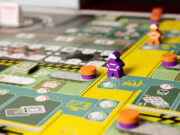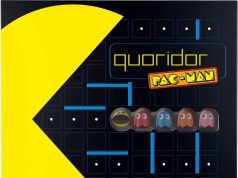 Themes in tabletop games used to come in two general varieties: Entirely themeless—think Mancala—and late 90s Euro-style themes involving trading goods in an “exotic” locale (which is to say: also themeless). In recent years, Euro games have decided to abandon some of the traditional themes in favor of fresh—and increasingly bizarre—settings. Enter Nucleum, which is a train game that has trains but also has a magical (?) resource (?) that powers everything in this futuristic (?) world.
Themes in tabletop games used to come in two general varieties: Entirely themeless—think Mancala—and late 90s Euro-style themes involving trading goods in an “exotic” locale (which is to say: also themeless). In recent years, Euro games have decided to abandon some of the traditional themes in favor of fresh—and increasingly bizarre—settings. Enter Nucleum, which is a train game that has trains but also has a magical (?) resource (?) that powers everything in this futuristic (?) world.
Nucleum is designed by David Turczi and Simone Luciani, tables 1-4 players, and takes about 150 minutes to play.
Gameplay Overview:
When first faced with the daunting task of giving a rules overview for such a complicated game, I was a bit overwhelmed. I turned to my dear friend and BGQ colleague Brandon Bryson for advice. His advice: “Broad strokes, my friend. Broad strokes.” So here goes: In Nucleum, players do a bunch of stuff that will earn them points, and then, eventually, one of them will win.
In slightly less—but still very—broad strokes: Nucleum is a route-building and action-selection game. Each turn, players will select one of the action tiles in front of them and trigger the associated action(s). This is done by either taking the action tile and adding it to the top of one’s individual player board, adding a tile as a route to the main board, or recharging their pool of action tiles.

Without going into too much detail (BGQ only has so much ink in its coffers, after all), the non-board actions will help players in a variety of ways, like increasing the size of one’s action pool or unlocking new personal scoring opportunities. Playing a tile onto the main board gives players the opportunity to not only expand the route toward one of the game’s coveted production locations but also trigger extra actions if they’re able to link up colors on one or both of the two-sided action tiles. Doing this board action requires placing a worker from one’s supply.
The actions themselves aren’t particularly complicated, but there are a ton of them at each player’s disposal—complete with a ton of icons. Players can upgrade their player board to hold more stuff, place buildings on the map, and increase their income, among other things. One of the major actions of the game involves “Energizing” the buildings but sadly doesn’t involve a large pink bunny. This action contains a series of other actions and fills building spots with resources that players can grab and transport.
Scoring in the game comes in a variety of ways as well, from hitting milestones (first person to mention the Energizer bunny in a Euro-game review and stuff like that), scoring VP by upgrading one’s player board, having energized buildings, and a bunch of other ways. There’s more—a lot more, in fact, but Brandon told me to be broad so that’s what I’ve done. Oh… and Nucleum is the name of a new resource type. So, there’s that.

Game Experience:
You know how many modern game reviews will include some kind of disclaimer like “even though the game looks complicated, there’s actually not that much going on”? Well, that isn’t Nucleum. This game both looks complicated and there is a ton going on.

As I mentioned at the outset: there’s a whole bunch to consider on every turn of Nucleum. Players need to weigh which action tile they’ll select and then which way they’ll orient it on the board and then the order they want to launch the associated actions, all while considering how these decisions connect to the overall goal of creating a decent production path so their trains can transport (or at least use, I guess) the coveted resources. It’s a real head trip from turn to turn and is already pretty dizzying in the first turn of the game.
This dizzying aspect leads me to what I consider to be the main and, for me, most obvious negative I can point to in the design of the game. The nature by which resources are “spawned” at the various plants can be difficult to properly understand, as is internalizing exactly which route each plant will eventually supply. I realize that this is a main function of games like this, and perhaps more experienced trainers (is that what people who play train games call themselves?) won’t have any issues, but I found myself tracing routes with my finger on the board a lot more than I feel like I should have.

The way these decisions interact can be quite satisfying, however, particularly in the ways that might seem the most obvious. Lining up a color match to cascade a few actions is always fun and upgrading one’s unique player board is neat—both in terms of increasing gameplay options and tactically pushing cardboard chits into place. The longer-term strategies, however (the actual route-building basically), tend to feel more like a slog than anything else. I get it: the game is designed to reward the type of forward-thinking one needs to have to lay out and/or piggyback effective tracks, but often there are so many moving parts that it will take turns upon turns to generate anything rewarding on the board.
I will say that I suspect that’s actually a feature of the game and not a bug; players who are into this heavy of a game are likely looking for that type of experience. For my part, I found it to be a little too protracted to actually be “fun.” And ultimately, that’s where I kind of land on Nucleum overall.
Final Thoughts:
I appreciate a lot of the things in Nucleum. It’s a great-looking game with an interesting, if weird and incomprehensible, theme. For me, though, it just wasn’t terribly fun. It felt like work, even in the moments when there was fun mixed in. I fully recognize that there will be a great many people who will love this game for all the reasons I don’t, but I do wonder if even those in the audience for whom that is true will really remember this game clearly in a few years.
Final Score: 3.5 Stars. Something of a split decision for this one; a good design that will appeal to some, but one that ultimately isn’t for me.
 Hits:
Hits:
• Good components and art for a Euro
• Lots of ways to score
• Good (?) theme (?)
Misses:
• Tough to pick the rules on the first few plays
• Sprawling board can be difficult to keep track of
• Mediocre and overly complex solo mode





















